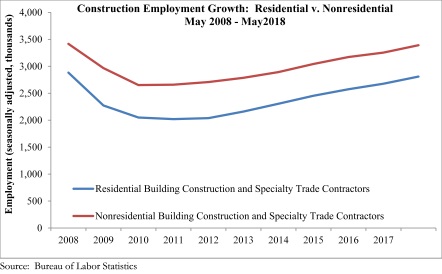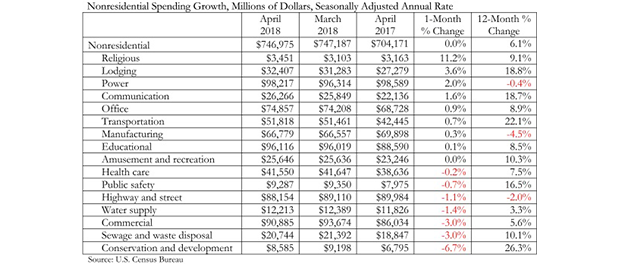By Roland Murphy for Arizona Builder’s Exchange
Three recent reports show the economy is buzzing right along, but more frequent concerns are being expressed.
The first, a Nelson J. Schwartz article published in the New York Times, pointed out the economy added 223,000 jobs in May – 33,000 more than experts had expected – to land at an employment of 3.8 percent, the lowest it has been since April, 2000.
“It was the 92nd consecutive month of job creation,” Schwartz wrote. “Most economists expect the momentum to continue, but a deeper drop in the unemployment rate or a big bump up in average hourly earnings would stoke fears of inflation and, in turn, a more hawkish Federal Reserve.”
While the news was robust, he noted it not likely to be so strong as to prompt the Fed to move more quickly to raise interest rates than it had already been planning. This news caused a boost in stock markets.
One downside for workers and consumers, however, is a general lack of
wage growth. In a market with such low unemployment numbers wages should be going up as companies work to retain and attract talent.
Schwartz sites a potential finding from Torsten Slok, chief international economist at Deutsche Bank, who believes that people who take new jobs may be getting raises, signing bonuses or other financial incentives to switch, those who are staying in their current job are not. Currently, according to Slok, 15 percent of people who have stayed in their current job haven’t seen a raise in the past 12 months. That number is usually closer to 10 percent.

Construction Employment
Another report last week, this one by Associated Builders and Contractors, found the construction sector added 25,000 jobs in May. Year over year construction has gained 286,000 jobs.
According the ABC announcement, “Nonresidential construction employment increased by 15,400 net jobs for the month. Nearly all of that growth came from the nonresidential specialty trade contractor subsector, which added 14,800 net jobs in May. However, the nonresidential building subsector lost 4,400 net jobs in May.
“The construction industry unemployment rate plummeted 2.1 percentage points in May and now stands at 4.4 percent, the lowest level since July 2000,” the report stated.
ABC Chief Economist Anirban Basu said, “Despite all the noise regarding tariffs, trade wars, Italy, Spain and a myriad of other issues, the U.S. economy continues to move forward with conviction. Today’s employment report is rendered all the more impressive given the difficulty so many firms, including construction firms, report filling available jobs. The ongoing addition of jobs in nonresidential construction is both an expression of confidence as well as evidence of an industry that continues to benefit from economic growth.”
A second ABC report prepared by Markstein Advisors, estimated April construction unemployment rates fell in 19 states on a year-over-year basis, were unchanged in four states and rose in 27 states, according to an analysis of U.S. Bureau of Labor Statistics data.
“Colder-than-normal temperatures in the eastern half of the country, combined with above-average precipitation in much of the eastern third of the nation, were likely factors in somewhat slower construction activity in April and a slightly elevated national construction unemployment rate compared to a year ago. Nonetheless, demand for construction workers continued to be healthy,” said Bernard M. Markstein, Ph.D., president and chief economist of Markstein Advisors, who conducted the analysis for ABC. “Employers are still reporting shortages of skilled construction workers, while building materials price increases hang like a cloud over future construction activity.”
Where are the Workers?
Taking a look back at the New York Times article, it’s noted that construction, energy and transportation have been, and continue to be especially tight. Companies are offering signing bonuses and other incentives to draw workers in, and they’re turning to unskilled or under-skilled workers at an increasing rate.
One observer they spoke with, Diane Swonk, an economist with Grant Thornton, said she is watching the teen labor market to see to what extent companies are adapting. The teen unemployment rate was 12.8 percent in May.
“The teenage unemployment rate is significant because this cohort is a prime beneficiary of tight labor markets, Swonk explained. When there was more slack in the system, teenagers had to compete with 50-somethings for scarce jobs. Now, as the latter group finds higher-paying positions, young workers are filling the gap.”
Schwartz noted in some markets companies are having no luck even in finding unskilled labor. Looking at transportation, he said Union Pacific in one area has started providing $20K signing bonuses for train crew workers, “a job requiring no experience or education beyond a high school diploma. In some cases, the company isn’t even waiting for students to graduate to start the recruiting process.”
Construction is not faring any better in overcoming its staffing shortages. A report from last year using U.S. Bureau of Labor Statistics data estimated there are 200,000 more construction jobs than there are workers to fill them. However, as companies can keep their heads above water, they should be able to maintain.
Toward that end, Basu said, “Construction firms should monitor their backlog with great care and be searching for any evidence of economic slowing. To date, however, there is little evidence of lost U.S. economic momentum.”

